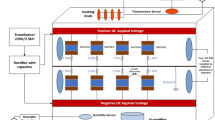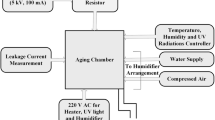Abstract
High temperature vulcanized silicon rubber (HTV-SiR) insulating materials are employed around the globe for the outdoor insulation of high voltage transmission lines. The biodegradable nature of these materials is the main hurdle to their reliable operation under severe outdoor conditions. For this reason fillers with different sizes, concentrations, shapes and dimensions are added to the base polymers to improve their performance. In this work, one pristine and three HTV-SiR composites were prepared having micro/nano fillers of silica and ATH. The samples were placed in a specially fabricated weathering chamber for a time period of 5000 h having different stresses along with bipolar DC voltage. The performance of prepared composite materials was analyzed using electrical, mechanical, thermal, surface and chemical analysis techniques. After aging, the highest value of leakage current recorded for sample S1 was 8.12 µA under positive DC voltage and the lowest value recorded was 5.82 µA for sample S4 under negative DC voltage. S1 became hydrophilic having HC4 and HC5 classes and S4 retained its hydrophobicity having HC3 and HC2 classes under bipolar DC voltage at the end of aging duration. TGA results showed residual % yield for S1, S2, S3 and S4 was 35.4%, 40.99%, 42.84% and 45.9% respectively under positive DC voltage. Moreover, fourier transform infrared spectroscopic analysis revealed that hybrid composite S4 showed the highest intactness in siloxane backbone (Si–O–Si) bonds with a decrease in its peak of 32.3% for positive DC and 17.2% for negative DC. Scanning electron microscopy showed voids, cracks, increased roughness and chemical structure damages on samples S1 and S2, whereas, co-filled composites S3 and S4 had better surface morphology.










Similar content being viewed by others
References
Bahrman MP (2006) Overview of HVDC transmission. In: 2006 IEEE PES power systems conference and exposition, pp 18–23
Liu Y, Song Y, Yu Z, Shen C, Chen Y (2018) Modeling and simulation of hybrid AC-DC system on a cloud computing based simulation platform-CloudPSS. In: 2018 2nd IEEE conference on energy internet and energy system integration (EI2), pp 1–6
Long W, Nilsson S (2007) HVDC transmission: yesterday and today. IEEE Power Energ Mag 5:22–31
Kannan P, Sivakumar M, Mekala K, Chandrasekar S (2015) Tracking/erosion resistance analysis of Nano-Al (OH) 3 filled silicone rubber insulating materials for high voltage dc applications. J Electr Eng Technol 10:355–363
Moreno V, Gorur R (1999) AC and DC performance of polymeric housing materials for HV outdoor insulators. IEEE Trans Dielectr Electr Insul 6:342–350
Bruce G, Rowland S, Krivda A (2010) Performance of silicone rubber in DC inclined plane tracking tests. IEEE Trans Dielectr Electr Insul 17:521–532
Nazir MT, Phung BT (2018) Accelerated ultraviolet weathering investigation on micro-/nano-SiO2 filled silicone rubber composites. High Voltage 3:295–302
Nazir MT, Phung B (2016) Ultraviolet weathering resistance performance of micro/nano silica filled silicone rubber composites for outdoor insulation. In: 2016 international conference on condition monitoring and diagnosis (CMD), pp 1035–1038
Nazir MT, Xingliang J, Akram S (2012) Laboratory investigation on hydrophobicity of new silicon rubber insulator under different environmental conditions. Dimensions 160:7
Gubanski S (1988) Erosion resistance of different housing materials to UV irradiation and surface discharges action. In: 1988 fifth international conference on dielectric materials, measurements and applications, pp 37–40
Jawaid M, Thariq M, Saba N (2018) Durability and life prediction in biocomposites, fibre-reinforced composites and hybrid composites. Woodhead Publishing, London
Momen G, Farzaneh M (2011) Survey of micro/nano filler use to improve silicone rubber for outdoor insulators. Rev Adv Mater Sci 27:1–13
Nazir MT, Phung B, Li S, Akram S, Mehmood MA, Yeoh GH et al (2019) Effect of micro-nano additives on breakdown, surface tracking and mechanical performance of ethylene propylene diene monomer for high voltage insulation. J Mater Sci Mater Electron 30:14061–14071
Meyer L, Cherney E, Jayaram S (2004) The role of inorganic fillers in silicone rubber for outdoor insulation alumina tri-hydrate or silica. IEEE Electr Insul Mag 20:13–21
Cherney EA (2013) Nanodielectrics applications-today and tomorrow. IEEE Electr Insul Mag 29:59–65
Chen D, Chen F, Zhang H, Yin X, Liu X, Zhou Y (2015) Preparation and characterization of novel addition cured polydimethylsiloxane nanocomposites using nano-silica sol as reinforcing filler. Polym Int 64:1741–1746
Zha J-W, Dang Z-M, Li W-K, Zhu Y-H, Chen G (2014) Effect of micro-Si3N4-nano-Al2O, sub> 3 co-filled particles on thermal conductivity, dielectric and mechanical properties of silicone rubber composites. IEEE Trans Dielectr Electr Insul 21:1989–1996
Jeon Y, Hong S-K, Kim M (2019) Effect of filler concentration on tracking resistance of ATH-filled silicone rubber nanocomposites. Energies 12:2401
Sundararajan R, Graves J, Mohammed A, Baker A (2003) Performance evaluation of polymeric insulators aged in lab and field. In: 2003 IEEE Power Engineering Society General Meeting (IEEE Cat. No. 03CH37491), pp 219–224
Khan H, Mahmood A, Ullah I, Amin M, Nazir MT (2021) Hydrophobic, dielectric and water immersion performance of 9000 h multi-stresses aged silicone rubber composites for high voltage outdoor insulation. Eng Fail Anal 122:105223
Khattak A, Amin M, Ali M, Iqbal M (2020) Hydrophobicity investigation and life estimation of silicone rubber nanocomposites. Emerg Mater Res 9:200–205
Cheng L, Wang L, Guan Z, Zhang F (2016) Aging characterization and lifespan prediction of silicone rubber material utilized for composite insulators in areas of atypical warmth and humidity. IEEE Trans Dielectr Electr Insul 23:3547–3555
Amin M, Khattak A, Ali M (2018) Accelerated aging investigation of silicone rubber/silica composites for coating of high-voltage insulators. Electr Eng 100:217–230
Krzma A, Albano M, Haddad A (2015) Comparative performance of 11kV silicone rubber insulators using artificial pollution tests. In: 2015 50th International Universities Power Engineering Conference (UPEC), pp 1–6
Amin M, Mahmood A, Khattak A (2020) Accelerated multi stress aging and life estimation of polymeric insulators. In: 2020 17th International Bhurban Conference on Applied Sciences and Technology (IBCAST), pp 55–61
Mahmood A, Amin M, Khan H, Israrullah FM, Ejaz T (2020) Investigation of multiple-stresses on mechanical and thermal properties of 9000 h Aged RTV-SiR composites for high-voltage insulation. J Elastomers Plastics 2:95244320953588
Akbar M, Ullah R, Qazi I (2020) Multi-stress aging investigations of HTV silicone rubber filled with Silica/ATH composites for HVAC and HVDC transmission. Eng Fail Anal 110:104449
Ullah I, Akbar M (2022) Anti-aging characteristics of RTV-SiR aided HV insulator coatings: Impact of DC polarity and fillers. Mater Chem Phys 278:125634
Ullah I, Akbar M, Khan HA (2022) Enhancement of electrical, mechanical and thermal properties of silicone based coating with aluminatrihydrate/silica for ceramic insulators. Mater Chem Phys 282:125972
Amin M (2013) Methods for preparation of nano-composites for outdoor insulation applications. Rev Adv Mater Sci 34:173–184
Singha S, Thomas MJ (2008) Dielectric properties of epoxy nanocomposites. IEEE Trans Dielectr Electr Insul 15:12–23
Schadler LS (2003) Polymer-based and polymer-filled nanocomposites. Nanocom Sci Technol 2:77–153
Schneider H, Guidi W, Nicholls C, Hall J, Burnham J (1992) Accelerated ageing chamber for non-ceramic insulators. Power Technol Int UK 1992:555
Sundararajan R, Soundarajan E, Mohammed A, Graves J (2006) Multistress accelerated aging of polymer housed surge arresters under simulated coastal Florida conditions. IEEE Trans Dielectr Electr Insul 13:211–226
Guide S (1992) 92/1 Hydrophobicity classification guide. Swedish Transmission Research Institute, Swedish
Nandi S, Reddy BS, Sharma D (2019) Performance of composite insulators used for electric transmission under extreme climatic conditions. J Mater Eng Perform 28:5959–5969
Reynders J, Jandrell I, Reynders S (1999) Review of aging and recovery of silicone rubber insulation for outdoor use. IEEE Trans Dielectr Electr Insul 6:620–631
Liang Y, Ding L, Yang K, Li C, Tu Y (2007) Study on hydrophobicity recovery characteristics and mechanism of HTV silicone rubber after corona deterioration. In: 2007 annual report-conference on electrical insulation and dielectric phenomena, pp 308–311
Kim J, Chaudhury M, Owen M (1999) Hydrophobicity loss and recovery of silicone HV insulation. IEEE Trans Dielectr Electr Insul 6:695–702
Hillborg H, Gedde U (1999) Hydrophobicity changes in silicone rubbers. IEEE Trans Dielectr Electr Insul 6:703–717
Nazir MT, Phung B, Hoffman M (2016) Performance of silicone rubber composites with SiO2 micro/nano-filler under AC corona discharge. IEEE Trans Dielectr Electr Insul 23:2804–2815
Ullah R, Akbar M, Amin S (2020) Measuring electrical, thermal and mechanical properties of DC-stressed HTV silicone rubber loaded with nano/micro-fillers exposed to long-term aging. Appl Nanosci 10:2101–2111
Zong Y, Gui D, Li S, Tan G, Xiong W, Liu J (2015) Preparation and thermo-mechanical properties of functionalized graphene/silicone rubber nanocomposites. In: 2015 16th international conference on electronic packaging technology (ICEPT), pp 30–34
Khan H, Amin M, Ahmad A, Yasin M (2018) Water immersion/liquid permeation resistance analysis of micro/nano-SiO2 filled silicone rubber and epoxy composites for high voltage insulation applications. In: 2018 15th international bhurban conference on applied sciences and technology (IBCAST), pp 16–21
Wietzke S, Jansen C, Reuter M, Jung T, Kraft D, Chatterjee S et al (2011) Terahertz spectroscopy on polymers: a review of morphological studies. J Mol Struct 1006:41–51
Wen X, Yuan X, Lan L, Hao L, Wang Y, Li S et al (2017) RTV silicone rubber degradation induced by temperature cycling. Energies 10:1054
Verma AR, Reddy BS (2018) Tracking and erosion resistance of LSR and HTV silicon rubber samples under acid rain conditions. IEEE Trans Dielectr Electr Insul 25:46–52
Author information
Authors and Affiliations
Corresponding author
Ethics declarations
Conflict of interest
The authors have no conflicts of interest to declare. All co-authors have seen and agree with the contents of the manuscript and there is no financial interest to report. We certify that the submission is original work and is not under review at any other publication.
Additional information
Publisher's Note
Springer Nature remains neutral with regard to jurisdictional claims in published maps and institutional affiliations.
Rights and permissions
Springer Nature or its licensor (e.g. a society or other partner) holds exclusive rights to this article under a publishing agreement with the author(s) or other rightsholder(s); author self-archiving of the accepted manuscript version of this article is solely governed by the terms of such publishing agreement and applicable law.
About this article
Cite this article
Mahmood, A., Alam, S. Performance and degradation analysis of HTV-SiR polymeric composites under the influence of bipolar DC voltages along with multiple stresses. Polym. Bull. 80, 11069–11089 (2023). https://doi.org/10.1007/s00289-022-04592-6
Received:
Revised:
Accepted:
Published:
Issue Date:
DOI: https://doi.org/10.1007/s00289-022-04592-6




